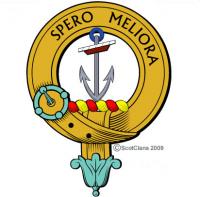
Clan Rait
The surname Rait, also seen as Raitt and Rate, has been taken from different places all over the country, and so many of the families who assumed this name are not actually related to one and other.
Nairn, Perth, and Ayrshire all have places named Rait, aswell as Fife with Raith.
The ancient castle of Rait, near Geddes, Nairn, is where the family Rait of that Ilk took their name, but as of around the start of the 15th century, they had almost completely vanished from the north.
The knight Sir Gervase de Rathe was the constable of Invernairn in 1292, and in 1296, under the name of Gervays de Rate, he pledged his allegiance to Edward I of England by signing the Ragman Roll. Several others of this surname also signed the scroll.
The English king gave Gervase Rate's brother, Andrew, all of Gervase's lands in Scotland in return for safe conduct papers to travel in Scotland on the king's business in 1297.
A charter by John Comyn (cousin of the John Comyn killed by Robert the Bruce in Dunfries, 1306), Earl of Buchan, was witnessed by Andreas de Raath in 1299.
A lease of property, for land in village of Glesbany, was witnessed in 1321by John de Ratis.
It is recorded that in Scon (Scone), in 1332, an agreement between John de Rate and the abbot and convent was made, and after a brief episcopate, John Rait, bishop of Aberdeen died in 1355.
David Rat was a recorded citizen of Brechin in 1471, Gavin Rath was commissary, in 1477, of William Scheves, archdeacon of St. Andrews, and in Glasgow, in 1487, Andrew Rayt was recorded as being in possession of a tenement.
An old family in the Mearns area were the Raits of Hallgreen.
Other recorded spellings of this name include Raitht, Reat, and Reyth.




